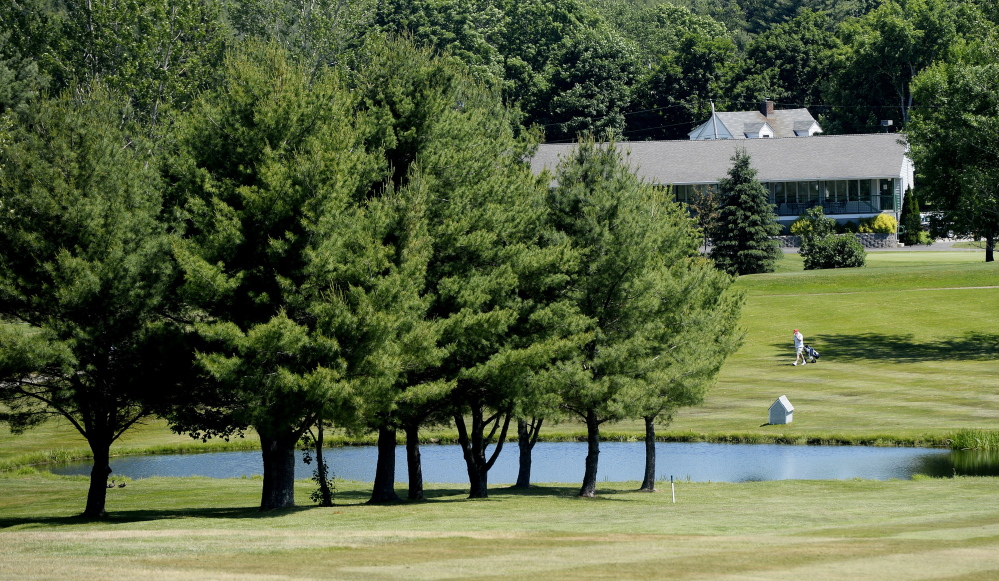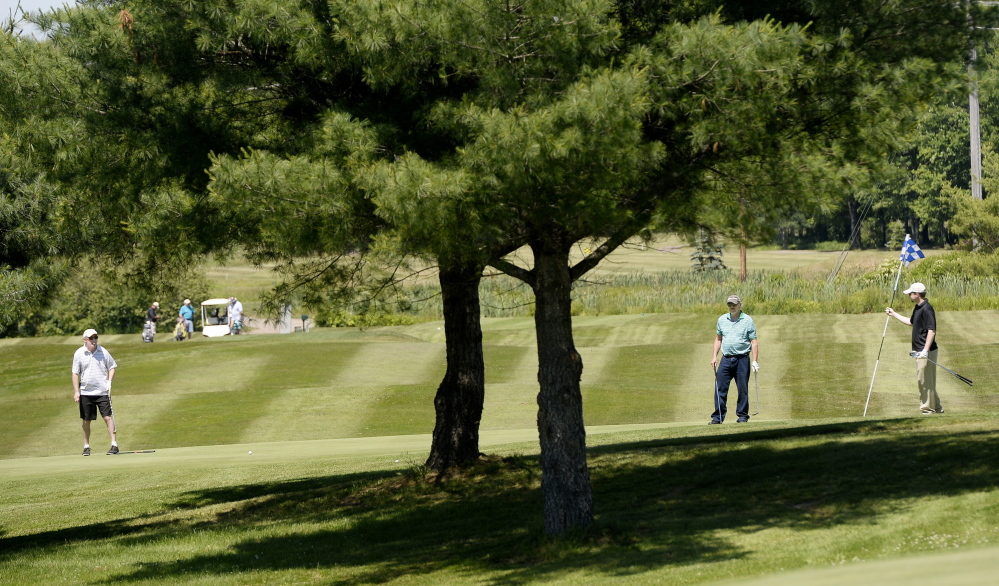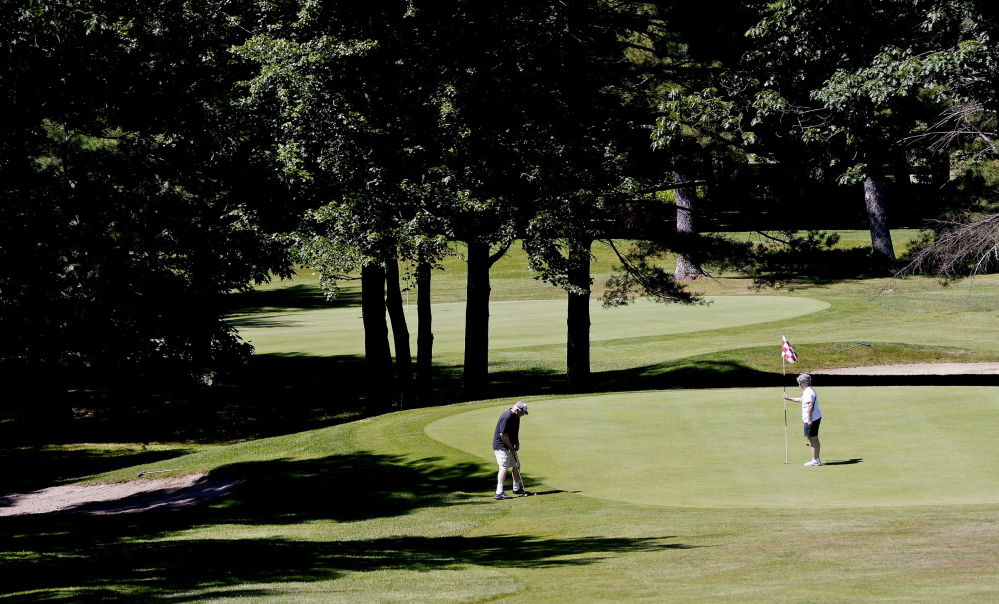ARUNDEL — If you happened to drive by Dutch Elm Golf Club in Arundel early last week, you may have noticed a new black hearse behind the clubhouse.
Don’t worry, no one died. Nor was it a statement on the course’s condition.
Unlike several Maine courses whose greens took a beating last winter, Dutch Elm’s greens are in excellent shape. They’re fast and roll true.
The hearse? It was the prize for a hole-in-one in a funeral directors tournament dubbed the Mortician Open. The hearse was driven to the 11th hole, a downhill par 3, for the event.
Jeff Hevey, who owns the course with his father, Norm, who is semi-retired, said he hoped a golfer would win the hearse. No one did but if they had, Hevey joked, “I’m sure it would have been on ‘The Tonight Show with Jimmy Fallon.’ ”
Jeff Hevey is the third generation of his family to run the course. His grandfather, Lucien Bourque, who ran a construction company, built a nine-hole course in 1965. It expanded to 13 holes in the 1970s and became 18 in 1980.
The opening nearly 50 years ago featured four of the state’s top pros playing an exhibition. One of them, Jim Veno, drove the 345-yard, 90-degree dogleg right, uphill eighth hole, now the 17th. That couldn’t be done today because the trees have reached full height, but back then they were just saplings and Veno, known for his prodigious drives, had no trouble.
A few golfers matched Veno’s feat when the trees were still small, but he was the first and it remains a favorite story at the 19th hole.
The golf course, named after the trees prevalent on the land when it was built, offers a variety of holes and elevation changes.
“The first seven holes are pretty flat,” said Hevey, who started working on the course as an 8-year-old mowing greens. “Holes eight and nine go up and down the hill.”
The par-4 10th is uphill. The 11th, at anywhere from 173 to 150 yards, is one of the most scenic and challenging holes. Stray a little right or left on your tee shot and your ball could end up in a bunker.
The course starts with a relatively easy 300-yard par-4 first hole. Easy, that is, if you don’t slice your drive out of bounds on the right, where Brimstone Road runs parallel. It’s the first shot of the day and you’re probably a little nervous.
“A lot of golfers go left just to be safe,” said Hevey. “The green is a turtle back. If you hit your shot to the pin, it’s probably going to roll off.”
Hevey calls No. 2, a 500-yard, dogleg right par 5, the hardest hole on the front nine.
“Water can come into play on the drive. If you pull it left, you’re wet. The second shot is one of the hardest on the course. It gets a little narrow because another pond comes into play,” he said.
The course got permission from the power company to put a back tee, which lengthened the hole to a par 5. Power lines split the front nine.
A unique aspect of Dutch Elm is it has back-to-back par 3s on the front and back nines. Holes, 7, 8, 11 and 12 are 3s. It also had three straight par 5s on the back nine – 13, 14 and 15. The 15th, which measures 448 yards from the back tees, was changed to a par 4 for men but remains a par 5 for women.
“It’s the No. 1 handicap hole,” said Hevey of the 15th, a dogleg left.
There are several ponds throughout the course that can come into play on the tee shot. That’s true on the second, third, ninth, 14th, 15th and 18th. The ninth and 18th tees offer panoramic views of the clubhouse and beyond.
To score well, you have to move your tee shot left or right. There are five doglegs.
Ron Gagnon, a longtime member and one of Dutch Elm’s top players, said the bowled-shaped greens taught him how to stop a shot.
“That’s helped when I play other courses,” said Gagnon. “Stopping the ball on those greens are a piece of cake.”
Gagnon’s favorite hole is the par-4 fourth, which measures 367 yards from the back tees. It’s a dogleg left and Gagnon likes it for the strategy required.
“You can hit your driver but if you turn it left too much, you could go in the pond. If you push your tee shot it might end up in the bunker. You don’t see a lot of birdies on the hole,” said Gagnon.
It’s a given that golfers want to play on good greens. They’ll put up with less-than-ideal fairways as long as the greens are in good shape.
“We came through the winter in great shape,” said Hevey, who studied turfgrass science and management at the University of Massachusetts’ Stockbridge School of Agriculture.
“We haven’t had any temporary greens. We cleared our greens of snow and ice on March 15.”
On a recent Monday, the parking lot was filling up by 8:30 a.m. One threesome was playing the ninth hole, which means they started around the first tee time of 6:30 on weekdays. The first tee time on weekends is 6 a.m.
“This is a typical Monday,” said Hevey. “Every Maine course seems to be busy in the morning. There’s a lull during 1 to 3 in the afternoon and it gets busy again later in the afternoon. We have 280 members and that’s pretty good for us. We try to be around 300.”
The course members arrive from Arundel, Biddeford, Saco and Wells. A lot of them are retirees.
“We have a lot of members with handicaps in the teens,” said Hevey. “They enjoy playing with their friends, their wives and kids. We have a very active membership. We have 64 players in our men’s league and we have 70 people signed for our two-ball tournament.”
Now that summer has arrived, Dutch Elm will look to get its share of tourists and locals looking to tee it up for a reasonable price.
“We get a lot of vacationers from Wells Beach,” Hevey said. “We run a special. Golfers can play as many holes, starting at 2 p.m., for $29 walking or $41 with a cart. Guys love that. They often play 20 to 25 holes. It’s usually dark when I pick up the last cart.”
Promotions such as these help the course’s bottom line.
“You have to work harder for the dollar now. In the 1990s when Tiger Woods started as a pro, golfers were beating down the door to play,” said Hevey.
“There are more golf courses than there were 10 years ago and not as many golfers. There aren’t as many family-owned courses. You have companies that own several courses and it’s tough to compete. Advertising is a little easier when you’re advertising 10 courses instead of one.”
Send questions/comments to the editors.






Success. Please wait for the page to reload. If the page does not reload within 5 seconds, please refresh the page.
Enter your email and password to access comments.
Hi, to comment on stories you must . This profile is in addition to your subscription and website login.
Already have a commenting profile? .
Invalid username/password.
Please check your email to confirm and complete your registration.
Only subscribers are eligible to post comments. Please subscribe or login first for digital access. Here’s why.
Use the form below to reset your password. When you've submitted your account email, we will send an email with a reset code.